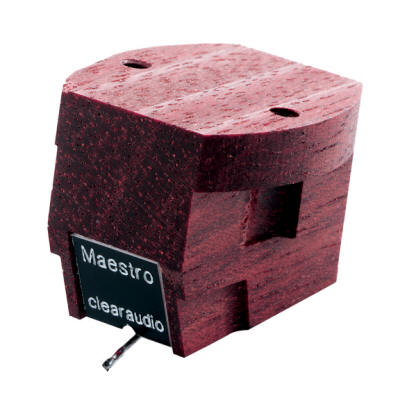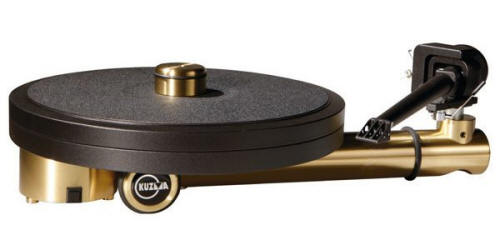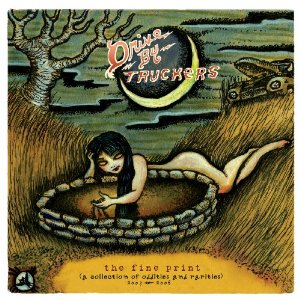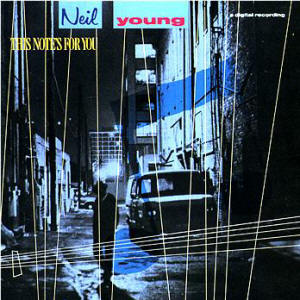|
|
You are reading the older HTML site
Positive Feedback ISSUE 61
clearaudio Maestro Moving Magnet Cartridge as reviewed by Francisco Duran
What's happening? The Foo Fighters putting out their latest album on analog tape, with no pro tools used in the recording? I just got through watching the documentary, It Might Get Loud, and there was Jimmy Page playing records. Jack White was playing too with an analog tape deck off in the distance! Personally I would love to hear a little tape hiss on a new recording, just to bring back old memories. To most audiophiles, the dribble of trendy hipsters and their surprise that people still use turntables is pure nonsense. We never stopped using our turntables. No matter what digital trend pops up every minute. In fact as we all know analog has been alive and well and doing quite well for itself these past few years. The subject of this review, the Clearaudio Maestro moving magnet cartridge, is from Clearaudio dealer Musical Surrounding of Oakland, California. Over the years I have dealt with Mr. Garth Leerer and Mr. Mike Fajen of Musical Surroundings. Kudos has to be given to this organization for their excellent customer service. The credentials of Clearaudio hardly need mentioning on this website. Their range of turntables, arms, and cartridges is mind blowing. The Maestro is the top of the line moving magnet from Clearaudio, stacking up just above another well-known cartridge of theirs, the Virtuso Wood. The Maestro's output voltage is 3.6 Ohms, loading range is 47 Kohms. It weighs 7.0 grams, with a compliance of 15, and a tracking range of 2.0 to 2.5 grams. It has a Boron cantilever, and the recommended replacement for the stylus time is 2000 hours, or sooner if you are rough with your styluses. Please don't attempt to do it yourself. A trained professional is needed to do that job. The Maestro retails for $1200. Who likes the break in process? Especially when you know that with every spin of a disk, you are shaving off the life expectancy of a cartridge and also the record. Fortunately out of the box, as they say, the performance of this cartridge is very easy on the ears. Improving and blossoming past the 50-100 hour mark. In the past, some very good friends helped me set up my cartridges, that is until another good friend of mine urged me to take the bull by the horns and learn how to properly mount a cartridge all by my lonesome. My Bluepoint No. 2 MC cartridge was really intended for this purpose. It was only meant to be used as an interim cartridge, but its use went past my installation learning curve. So when it came time to mount the Maestro on my Kuzma Stabi S/Stogi S table and arm combo, out came my Hi Fi News and Kuzma alignment tools, along with my trusty Expressimo Audio X-treme digital tracking force gauge. I set about the task of aligning this cartridge. My also very trusty Cardas and Clearaudio strobe disks were used to create a very near perfect set up. You can never have too many tools. The Maestro comes with two mounting plates that fit between the cartridge and arm. The aluminum one is meant to be used with the Satine wood bodied cartridge (the subject of this review) and the plastic one for the aluminum bodied cartridge. The wood body is threaded (thank you) and it comes with a clear plastic stylus guard which I use on a regular basis due the stylus sticking out a bit on the front, more so than on other cartridges. Confession time, when it came time to adjust the azimuth, I used my handy dandy homemade cardboard guides and a set of eye balls. I don't own a Fosgometer. Remember I said " very near perfect." Besides the fantastic Kuzma Stogi S tonearm makes this adjustment a lot easier than on other arms. It has a grub screw adjustment on one of its two counter weights. Nice!
I won't go into how analog slams digital for sound quality. Most of you reading this already know that. You are probably reading this because you are interested in a high quality, affordable, good performing moving magnet cartridge. The Maestro meets those requirements with ease. I will say this; I have a very high quality clean sounding CD player in my Marantz SA 15S2 Reference SACD player, modified by The Upgrade Company to a Signature Edition. Believe me as good as it is it can't out-perform the Kuzma/Maestro combo in regards to ease of listening. I can play albums literally for many hours at a stretch. Although I do play my CDP often, I just can't do that with digital. Sorry my attention wanders. I feel it is just inherent in the digital technology. Another thing is, I won't compare my old BP2 with the Maestro. It is a different cartridge in a different price bracket. It is good for what it is. I listened to the Maestro through the phono section of my Marantz Reference PM-15S1 integrated amplifier, also modified by The Upgrade Company to a Signature Edition. There are times that I feel this phono section doesn't have enough gain. Compared to my old separate phono stage, the Monolithic Sound PS-2, its gain could be set to ones heart's desire. Still the Upgrade Company's modification to the Marantz phono section is very good and the quality of its reproduction is quite high. Overall the Marantz combo is a pretty neutral platform for the Maestro to perform its duties. With that in mind for this review I played so many albums over quite some time that I almost don't know where I start. To get started I cherry picked a few of my favorites. I have a used copy of The Ozark Mountain Daredevils, Men from Earth. This has been one of my favorites for quite a long time. On track 4 side 2 "Arroyo", the number of instruments that are shaken, struck, stroked, and otherwise played is quite interesting. Two in particular the Guiro and the Claves have a clear, distinct, yet natural place on the soundstage. There is dimension (air if you will), and realistic tone to those two simple instruments that seems to raise the performance of this cartridge way above its retail price!
I picked The Drive by Truckers because I just love this band. I played their double LP, A Collection of Oddities and Rarities. These guys are all about drum kits, cymbal crashes, electric guitar crunching, and gritty vocals. I love it! The sound was clean and detailed without sounding etched, thin, or bright. The vocals sounded expressive, and I could hear the dynamic variations and vocal inflections with ease. These qualities were especially noticeable on side four; track one, "Mrs. Claus's Kimono." On the track "Play it All Night Long," the drums sounded tight, and rhythm was spot on in a spacious and dimensional soundstage. When both lead guitars start in, it gets loud but never goes into excess in regards to distortion. One hears just the right amount of midrange to upper treble harmonics as these electric guitars are getting their hearts strummed out of them. I couldn't get enough. Work came early the next day, but that didn't stop me from playing the whole double album before bed time.
For the next session I started with Neil Young's, This Note's for You. This is a classic album if there ever was one. Young's slam on corporate sell-outs is filled with catchy tunes, played by a veteran rock group, backed by a killer horn section. Those horns sounded smooth, polished, and dimensional yet with a natural brassy bite that a good recording can display. Through the Maestro, these qualities were easily heard. Again, there was a very spacious soundstage with very good depth, width, and height creating an organic sound field. There was a consistence of performance regarding the soundstage with well recorded material. And this slab of vinyl played on the Maestro certainly displayed very good qualities in this area. Pace and rhythm were not hampered a bit. Strangely enough, this was especially noticeable on the chorus of "This Note's for You." Neil's vocals were very natural sounding on this album. Transients and dynamics were not thin, and it wasn't hard, if you closed your eyes, to be transported to a little bar up north somewhere listening to the Blue Notes' smoky burn. Now let's move on to something a bit different. One of my classical favorites has always been The Pines of Rome by Loren Mazzel and the Cleveland Orchestra. It is on a half speed master pressed by the Victor Company of Japan. This is a Mobil Fidelity Original Master Recording originally on London. On this LP, I really don't know where to start. My notes start off with slightly warm, great dynamics, smooth treble. I slipped into the music and was listening without thinking of the system. The bass section was full and taut. There was a bloom in the lower octaves, yet it had a weighty presentation that flowed with ease. Bass transients were full and deep, well controlled, and articulate. On the first section, "Pines of the Villa Borghese," the music builds to a dynamic swell that is not unlike a large ocean wave sweeping you up, only to be caressed by the next movement, "The Pines near a Catacomb." The Maestro tracked these dynamic orchestral changes with solid assurance. Next up was Muti, Philadelphia, and The Rite of Spring again on MoFi. Call me a sucker for Stravinsky, but this music really gets my blood flowing. The Maestro showed very good tracking ability, and fine detail retrieval. I heard the sharp piercing flutes floating above the clarinets that transitioned to the bass violins with a seamless ease. The solid placement of images was only interrupted by the explosive dynamics on side one of this album. The high level of dynamic contrasts between orchestra sections held together with the high volume I gave it and did not break up a bit. I ran this LP through three different speaker systems, with and without a subwoofer. This was just the first side of the LP. I was in for a treat on side two! I was just relaxing and enjoying the music till the bass drums kicked in. Wow, talk about explosive dynamics! Here the Maestro reproduced excellent pace and very quick dynamics. This cartridge does not lack for speed. It held the music together well. Word on the street has it that the Maestro has the reputation to sound a bit thick, slow, and bland. But I did not find this to be the case with any type of music, especially classical. This is not a light as a feather, lightening quick cartridge. But it is not leaden or thick by any means. Besides, my mom always told me to take words on the street with a grain of salt. One more example of the many albums I played, and continue to play almost on a daily basis. Two LPs of Eric Satie both on Angel; the recording of his "Monotones and Parade," "Relache Ballets," and "Gymnopedies" were played in their entirety. The piano parts on these albums sounded fluid and full bodied, and had just enough spaciousness and detail to keep me on the couch squarely in front of my system for four sides. Ever listen to a piano played live? It doesn't sound bright. What these examples showed was a consistent performance across the board with the Clearaudio Maestro cartridge. The bass is deep, full, taut and well controlled. Dynamic swings hold firm no matter where the volume is set. This cartridge tracks very well. It displays lifelike images that are precisely placed on a well-proportioned stage, make that a huge soundstage. It has tone that is rich, round, and full, yet with a high degree of detail and realistic musical texture. Its treble is extended yet smooth and well balanced with the rest of the frequency range. With all of these qualities you would think that one would never need to investigate Clearaudio's more expensive MC cartridges. Well not exactly. Stepping up to the pricier MCs gets you better inner detail and more exact spatial dimensions. Greater speed, delicacy, and dynamics would also accompany the dearer MC cartridges. But I feel that two great strengths of the Clearaudio Maestro cartridge are its ability to come close to the musical qualities of its bigger MC Brother's without over doing it, and its sheer ability to draw you into the music and make it fun to listen to all kinds of music. This is all done in a solidly built unit at an affordable price. As a friend of mine used to say, "What more do you want?" The proof of my recommendation is in the fact that this Clearaudio Maestro cartridge is mine. And when it needs a new stylus, it is going back to Oakland California for a re-tip! As far as artists going back to their analog roots, I can only say keep up the good work! Analog bumper stickers should be issued! Francisco Duran
Maestro
Musical Surroundings
Clearaudio Electronic GmbH
|











